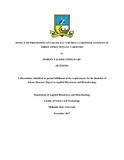Please use this identifier to cite or link to this item:
https://cris.library.msu.ac.zw//handle/11408/3552| Title: | Effect of processing on crude fat and beta-carotene content in three sweet potato varieties | Authors: | Chingwaru, Doreen Valerie | Keywords: | Sweet potato Food security Zimbabwe |
Issue Date: | 2018 | Publisher: | Midlands State University | Abstract: | Sweet potato (Ipomoea batatas) is one of the crops being considered for the diversification of the staple diet to enhance food security in Zimbabwe in the face of climate change and economic challenges. One of the hurdles preventing adoption of sweet potato as a staple food is its short shelf-life. There has been a call to explore means of preserving sweet potato hence increasing its shelf-life and one method of preservation is processing sweet potato into flour. However, this method has not been embraced because the effect of processing on sweet potato nutrient content is not known. A study was carried out to determine the effect of two methods of post-harvest processing (oven-drying and sun-drying) on fat and beta-carotene content of sweet potato in line with the ZIM ASSET clusters on food security under value addition and beneficiation. Three sweet potato cultivars -Chingovha (crème-fleshed), Germany II (white-fleshed) and Resisto (orangefleshed) were studied. The Soxhlet extraction method was used for fat content determination and the beta carotene content was determined using spectrophotometry. Sun-dried Germany II retained the highest fat content (0.09±.002g/100g) after processing. The fat content was below the threshold required for absorption of beta-carotene by the body (5g/100g). Resisto and Chingovha retained similar fat contents (0.02±.002g/100g – 0.04±.004g/100g). There were significant differences in fat content across the three cultivars and between fresh and processed sweet potato (ANOVA p<0.05). Resisto retained the most beta-carotene (8.33±0.039 mg/100g) after processing whereas Chingovha and Germany II had similar beta-carotene contents (0.7±0.039 – 0.75±0.039 mg/100g). There were significant differences in beta-carotene content across the three cultivars (ANOVA p<0.05) which lied between Resisto and Chingovha (Tukey multiple comparisons p=0.00) and between Resisto and Germany II (Tukey multiple comparisons p=0.00). Beta-carotene content in all three cultivars was converted to meet the average daily beta-carotene content intake requirements called Retinol Activity Equivalents (RAE) at a ratio of 1 µg/100g beta-carotene: 12 µg/100g RAE. Resisto had a RAE of 694-697.5µg/100g which met the average daily intake requirements for males and females aged 0-13 (400-600µg/100g). Resisto must be grown on a large scale because of its high beta-carotene content. Chingovha and Germany II had beta-carotene contents below the required RAE of 400 µg/100g therefore they need artificial fortification. When eating sweet potato, an accompaniment with a dietary fat of 3-5g/100g must be consumed for intestinal absorption of beta-carotene. Resisto was the best in terms of beta-carotene content after processing, therefore it is the most suitable cultivar for food security. Both sun-drying and ovendrying had similar effects on beta-carotene content although sun-drying yielded less losses in fat content in Resisto and Germany II, therefore sun-drying is a more effective method to use for sweet potato processing. | URI: | http://hdl.handle.net/11408/3552 |
| Appears in Collections: | Bachelor Of Science In Applied Biosciences And Biotechnology Honours Degree |
Files in This Item:
| File | Description | Size | Format | |
|---|---|---|---|---|
| Doreen Dissertation corrections.pdf | Full Text | 835.32 kB | Adobe PDF |  View/Open |
Page view(s)
134
checked on May 16, 2025
Download(s)
66
checked on May 16, 2025
Google ScholarTM
Check
Items in MSUIR are protected by copyright, with all rights reserved, unless otherwise indicated.



